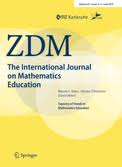 How a Chinese teacher improved classroom teaching in Teaching Research Group: a case study on Pythagoras theorem teaching in Shanghai by Yudong Yang published by ZDM Mathematics Education (2009) 41:279–296 DOI 10.1007/s11858-009-0171-y.
How a Chinese teacher improved classroom teaching in Teaching Research Group: a case study on Pythagoras theorem teaching in Shanghai by Yudong Yang published by ZDM Mathematics Education (2009) 41:279–296 DOI 10.1007/s11858-009-0171-y.
In China, a school-based teaching research system was built since 1952 and Teaching Research Group (TRG) exists in every school. In the paper, a teacher’s three lessons and the changes in each lesson were described, which might show a track of how lessons were continuously developed in TRG. The Mathematical Tasks Framework, The Task Analysis Guide, and Factors Associated with the Maintenance and the Decline of High-level Cognitive Demands developed in the Quantitative Under- standing: Amplifying Student Achievement and Reasoning project, were employed in this study. Based on the perspective of Mathematical Task Analysis, changes of three lessons were described and the author provided a snapshot for understanding how a Chinese teacher gradually improved his/her lessons in TRG activities.